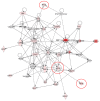Transcriptomic analysis of the temporal host response to skin infestation with the ectoparasitic mite Psoroptes ovis
- PMID: 21067579
- PMCID: PMC3091762
- DOI: 10.1186/1471-2164-11-624
Transcriptomic analysis of the temporal host response to skin infestation with the ectoparasitic mite Psoroptes ovis
Abstract
Background: Infestation of ovine skin with the ectoparasitic mite Psoroptes ovis results in a rapid cutaneous immune response, leading to the crusted skin lesions characteristic of sheep scab. Little is known regarding the mechanisms by which such a profound inflammatory response is instigated and to identify novel vaccine and drug targets a better understanding of the host-parasite relationship is essential. The main objective of this study was to perform a combined network and pathway analysis of the in vivo skin response to infestation with P. ovis to gain a clearer understanding of the mechanisms and signalling pathways involved.
Results: Infestation with P. ovis resulted in differential expression of 1,552 genes over a 24 hour time course. Clustering by peak gene expression enabled classification of genes into temporally related groupings. Network and pathway analysis of clusters identified key signalling pathways involved in the host response to infestation. The analysis implicated a number of genes with roles in allergy and inflammation, including pro-inflammatory cytokines (IL1A, IL1B, IL6, IL8 and TNF) and factors involved in immune cell activation and recruitment (SELE, SELL, SELP, ICAM1, CSF2, CSF3, CCL2 and CXCL2). The analysis also highlighted the influence of the transcription factors NF-kB and AP-1 in the early pro-inflammatory response, and demonstrated a bias towards a Th2 type immune response.
Conclusions: This study has provided novel insights into the signalling mechanisms leading to the development of a pro-inflammatory response in sheep scab, whilst providing crucial information regarding the nature of mite factors that may trigger this response. It has enabled the elucidation of the temporal patterns by which the immune system is regulated following exposure to P. ovis, providing novel insights into the mechanisms underlying lesion development. This study has improved our existing knowledge of the host response to P. ovis, including the identification of key parallels between sheep scab and other inflammatory skin disorders and the identification of potential targets for disease control.
Figures









Similar articles
-
Transcriptomic analysis of circulating leukocytes reveals novel aspects of the host systemic inflammatory response to sheep scab mites.PLoS One. 2012;7(8):e42778. doi: 10.1371/journal.pone.0042778. Epub 2012 Aug 3. PLoS One. 2012. PMID: 22880105 Free PMC article.
-
Host transcription factors in the immediate pro-inflammatory response to the parasitic mite Psoroptes ovis.PLoS One. 2011;6(9):e24402. doi: 10.1371/journal.pone.0024402. Epub 2011 Sep 7. PLoS One. 2011. PMID: 21915322 Free PMC article.
-
Development of a cDNA microarray for the measurement of gene expression in the sheep scab mite Psoroptes ovis.Parasit Vectors. 2012 Feb 8;5:30. doi: 10.1186/1756-3305-5-30. Parasit Vectors. 2012. PMID: 22316180 Free PMC article.
-
Sheep psoroptic mange: an update.Vet Parasitol. 2012 Sep 30;189(1):39-43. doi: 10.1016/j.vetpar.2012.03.030. Epub 2012 Mar 24. Vet Parasitol. 2012. PMID: 22525584 Review.
-
Inter- and intra-specific variation within the genus Psoroptes (Acari: Psoroptidae).Vet Parasitol. 1999 Jun 30;83(3-4):201-17. doi: 10.1016/s0304-4017(99)00058-8. Vet Parasitol. 1999. PMID: 10423003 Review.
Cited by
-
Predicting host range expansion in parasitic mites using a global mammalian-acarine dataset.Nat Commun. 2024 Jun 26;15(1):5431. doi: 10.1038/s41467-024-49515-3. Nat Commun. 2024. PMID: 38926409 Free PMC article.
-
Generation, analysis and functional annotation of expressed sequence tags from the ectoparasitic mite Psoroptes ovis.Parasit Vectors. 2011 Jul 22;4:145. doi: 10.1186/1756-3305-4-145. Parasit Vectors. 2011. PMID: 21781297 Free PMC article.
-
Adaptation in the Alleyways: Candidate Genes Under Potential Selection in Urban Coyotes.Genome Biol Evol. 2025 Jan 6;17(1):evae279. doi: 10.1093/gbe/evae279. Genome Biol Evol. 2025. PMID: 39786569 Free PMC article.
-
Preliminary analysis of Psoroptes ovis transcriptome in different developmental stages.Parasit Vectors. 2016 Nov 4;9(1):570. doi: 10.1186/s13071-016-1856-z. Parasit Vectors. 2016. PMID: 27809902 Free PMC article.
-
Draft Genome Assembly of the Sheep Scab Mite, Psoroptes ovis.Genome Announc. 2018 Apr 19;6(16):e00265-18. doi: 10.1128/genomeA.00265-18. Genome Announc. 2018. PMID: 29674543 Free PMC article.
References
-
- Sweatman GK. Biology of Otodectes cynotis, the ear canker mite of carnivores. Candian Journal of Zoology. 1958;36:849–862. doi: 10.1139/z58-072. - DOI
-
- DeLoach JR, Wright FC. Ingestion of rabbit erythrocytes containing 51Cr-labeled hemoglobin by Psoroptes spp. (Acari: Psoroptidae) that originated on cattle, mountain sheep, or rabbits. J Med Entomol. 1981;18(4):345–348. - PubMed
Publication types
MeSH terms
Substances
LinkOut - more resources
Full Text Sources
Miscellaneous

